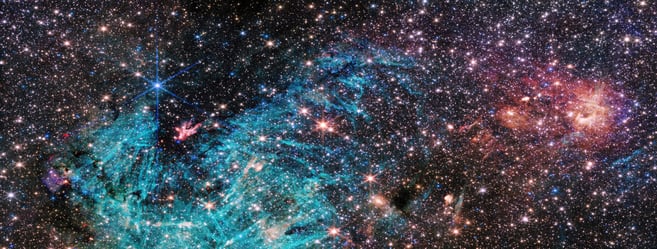
A new image released this week from the James Webb Space Telescope reveals a central portion of our Milky Way Galaxy in “unprecedented” detail, according to the Space Telescope Science Institute. It shows an estimated half a million stars.
The image, taken with the telescopes’ near-infrared camera, or NIRCam, shows the Milky Way’s dense core in a way scientists haven’t captured before. Whorls of cyan and blue push up against patches of pink and purple in a mesmerizing starfield.
But what does the image actually show? And what does it tell scientists?
The cyan in the image is a vast region of ionized hydrogen, which appears to be wrapped around a relatively empty field. But, the institute says, that’s actually an infrared-dark cloud, a region so dense it blocks the light of distant stars behind it from reaching the telescope.
The pinkish reddish blotch that looks like it’s nestled in the cyan region is a cluster of protostars — stars that are still being born.
“The image from Webb is stunning, and the science we will get from it is even better,” Samuel Crowe, the principal investigator on the observation team for this image, said in a statement. “Massive stars are factories that produce heavy elements in their nuclear cores, so understanding them better is like learning the origin story of much of the universe.”
Crowe is an undergraduate student at the University of Virginia and one of the first undergraduates to lead an observation project on the Webb.
In a statement, Rubén Fedriani, a co-investigator of the project, said the new observation from Webb “has provided us with a ton of data on this extreme environment, and we are just starting to dig into it.”
As an example, the institute said the “intriguing” needle-like shapes in the cyan region are structures that scientists plan to investigate further.
The telescope, which is many more times powerful than the Hubble Space Telescope, is operated out of the Space Telescope Science Institute, located on the Johns Hopkins University campus.
The teams working in Baltimore not only operate the telescope — which is a million miles away, orbiting the Sun — they also analyze the data the telescope collects to create the stunning images of outer space that NASA publishes.
Last month, the telescope itself was the subject of on-air mixup from Fox News host Laura Ingraham.
